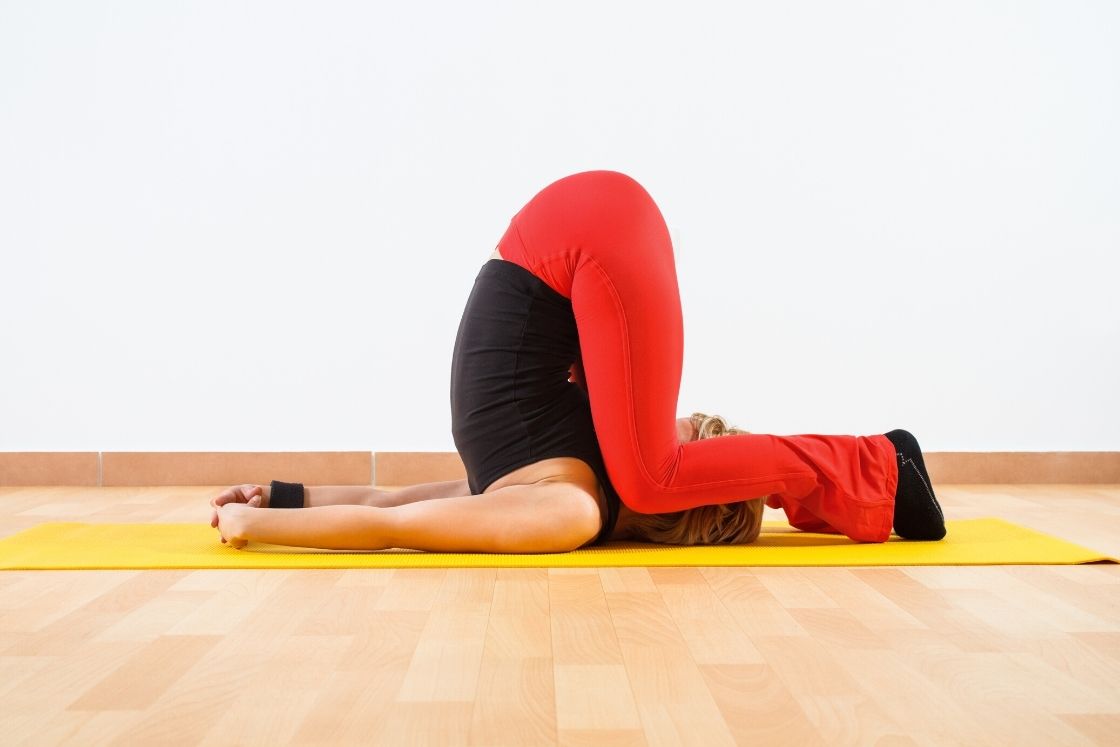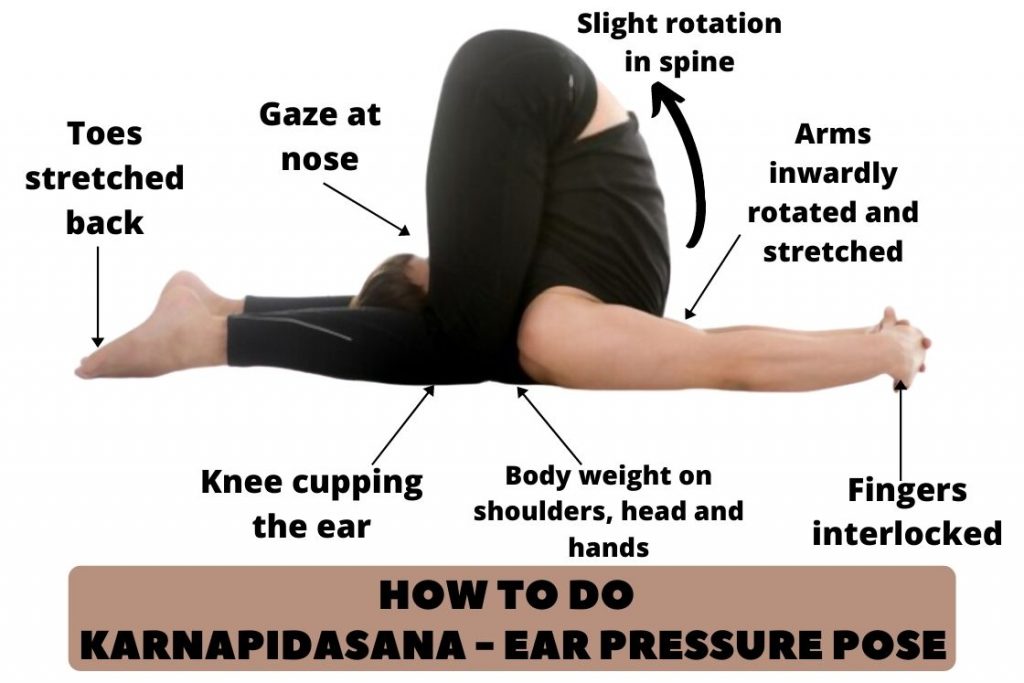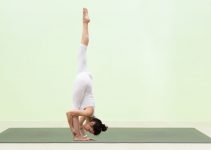
Karnapidasana is an advance deep inversion yoga asana. This asana is a prominent practice for spine extension, flexible hamstring, and mobilized shoulders.
Raja Halasana is another name by which Karnapidasana is known because it’s assumed an advanced pose of Halasana. Therefore teachers recommend Halasana a preparatory pose to leap into the Karnapidasana.
Karnapidasana and Halasana are part of the Traditional Ashtanga Yoga closing series and practiced one after another in sequence. The way our body transformed in these 2 asanas, it’s identified as one of the strongest trunk flexion sequence.
Meaning
Karnapidasana is a self-descriptive pose if you are a native Hindi or Sanskrit speaker. To reveal its meaning, Karnapidasana can break down in ‘Karna‘ means Ear and ‘Pida‘ means Pressure/force/ to squeeze. Hence, Karnapidasana means Ear Pressure Pose.
In this posture, Inward knees apply some pressure over the ears and obstruct the link from the surrounding. Hence, it’s named Ear Pressure Pose. However, Karnapidasana is also known as Ear to Knee Pose because of the same mechanism – bringing knees close to the ear.
Cutting off the external stimuli by blocking the ear in Karnapidasana reduces the unnecessary sounds, which could wither the concentration required for the asana practice. Therefore, introduces Pratyahara, one of the limbs of Eight limbs of yoga.
Hence, in Karnapidasana, Pratyahara is achieved by covering ears through knees and closing of eyes turns the mind inward for peaceful practice.
Practice Guide of Karnapidasana

Go through the following points below for safe and easy practice of Shalabhasana.
Precautions & Contraindications
- Practitioners with heart conditions should avoid or practice for a short period of time. Because an upside-down position can increase your blood pressure and decrease your heart rate.
- Pregnant women and during the menstrual cycle refrain from doing Karnapidasana.
- In the case of Slipped disc, Sciatica, neck or spine injury, and asthma practitioners should avoid this asana as the concerning areas get influenced.
- People with the condition of herniated disk and those who have undergone surgery in the past few months avoid practice this asana.
Preparatory Pose
- Plow Pose (Halasana)
- Child pose (Balasana)
- Downward-facing Dog Pose (Adho Mukha Svanasana)
Karnapidasana Steps
- Begin from the preparatory pose Halasana. After being in this asana for sometimes, tuck your shoulder inside.
- Now, slowly bend your knees and place left knee by the left ear and right knee to the right ear, respectively.
- Let your knees rest on the floor pressing the ear gently. It will overcome the aural distractions.
- Toes stretched and together along with the heels. Further, rest and stretch your arms on the floor as in Halasana.
- Remain in the posture for few breaths.
Release
Maintain the posture for 30 to 60 seconds. However, Practitioners with mastery in Halasana can increase the time period as per their level of practice.
After breathing a few breaths returns back by releasing your arms first and then spinal column vertebra by vertebra. Inhale few deep breaths and then relax.
Beginners Tips
- In the case of Beginners trying to leap directly into the could be unfruitful. It would be better to practice Halasana well before practicing Karnapidasana.
- Avoid movement of the head while in the posture. Unnecessary movements could result in injury.
Props and Modification
- If knees are unable to rest on the floor then one can use a block after bringing knees to their extremities.
- Inverted back can be supported either interlocking fingers of both hands or placing hands on the back of the rib cage.
- Pressure due to weight under the head can be reduced by using a folded blanket or towel.
Follow Up Poses
- Fish pose (Matsyasna)
- Firefly pose (Titibasana)
- Four-Limbed Staff Pose (Chaturanga Dandasana)
Karnapidasana Benefits
- Practicing this asana promotes the spine flexion, which strengthens muscles and eradicates pain. However, it also stretches the entire back that enhances spine flexibility and overcomes issues concerning movements.
- Inversion lays pressure on the Thyroid gland that results in its stimulation to release Thyroxine hormone. It regulates the metabolic activities of the body and plays a pivotal role in growth and development.
- Increased blood flow to the brain rushes oxygen-rich blood to the brain’s tissue, which overcomes stress and anxiety. Also improve alertness. Therefore, the regular Practice of Karnapidasana promotes relaxation in the mind and body.
- Backward roll of the shoulder assists in stretching torso, which further improves respiration. According to one study, , practicing Karnapidasana along with other Yoga practices results in the strengthening of respiratory muscles and tolerance of respiratory centers against higher pCO2.
- Pressure on the abdominal region massages various internal organs along with the digestive. It stimulates the Jatharagni or Digestive fire that increases appetite and assimilation process and overcomes constipation and gastric problems as well.
- The regular practice of Karnapidasana burns extra-abdominal fat. According to one study, regular practice of this asana along with other Yoga practices Decreased body weight, BMI, PI, skinfold thickness, fat percentage, etc.
- This asana tones up inner thighs, improve the flexibility of pelvis, and eradicates lower back pain.




